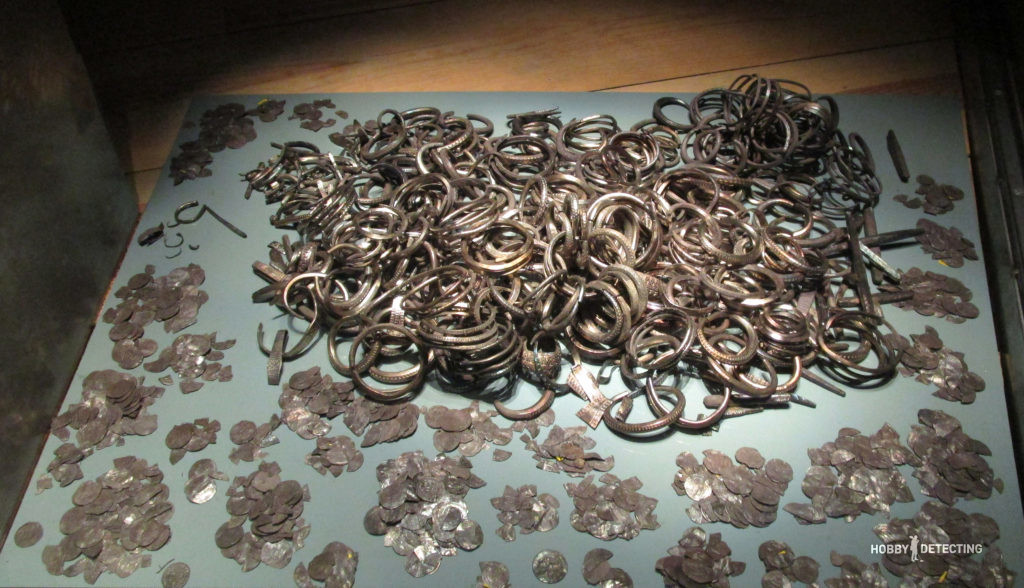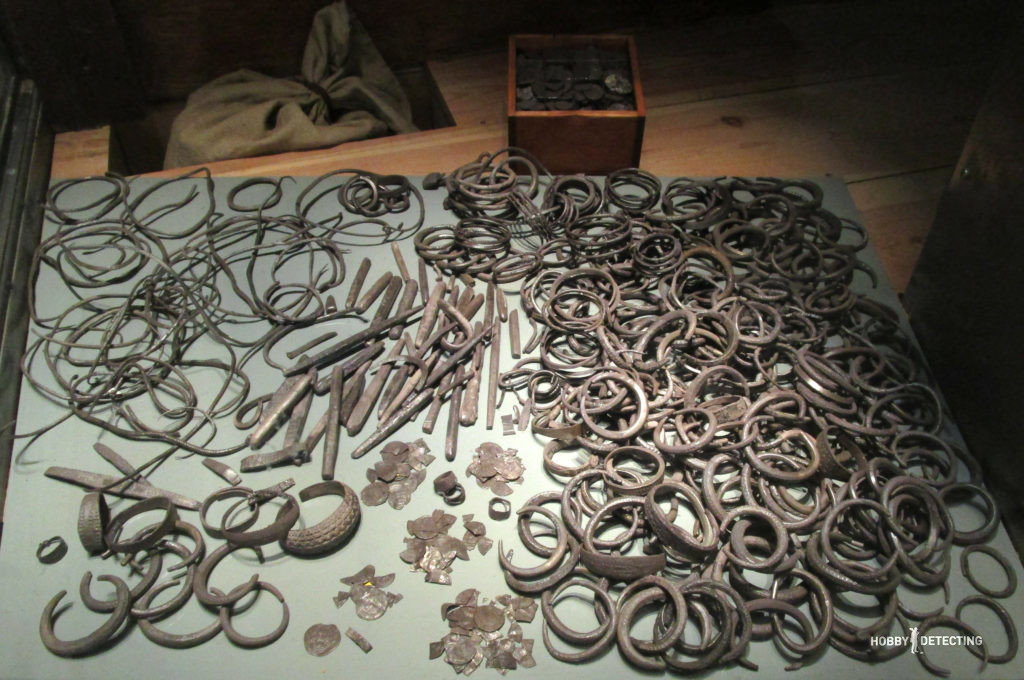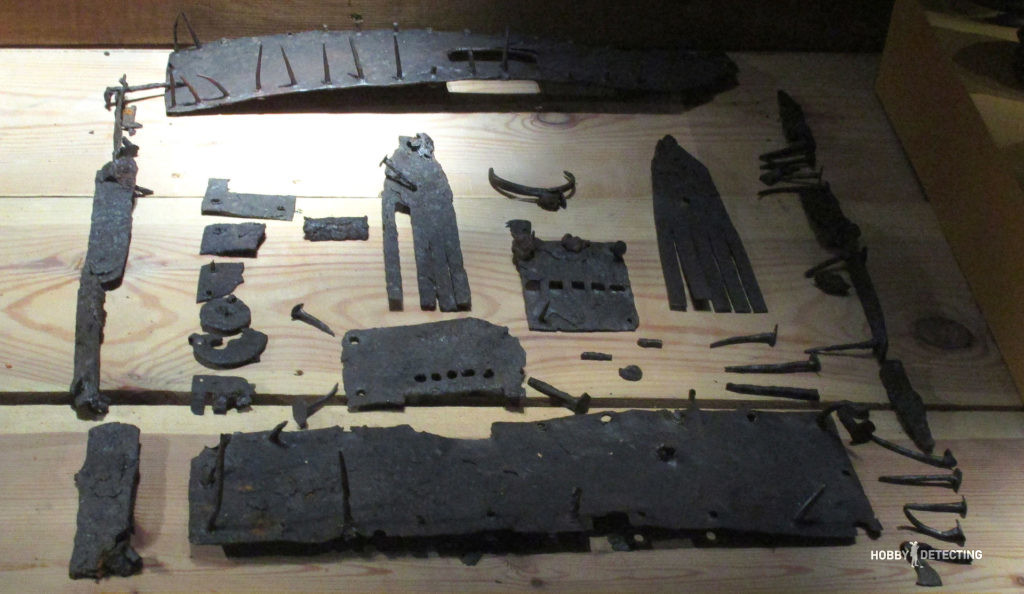When Viking bracelets are dug with buckets (photo+)

The world’s largest hoard of silver was found on Friday, July 16, 1999, in a field near Spillings Farm, northwest of Slite in the northern part of the island of Gotland in Sweden.
The total weight of the treasure was 67 kg of silver and 20 kg of bronze! There were 14,295 Arabic and other coins alone! Archaeologists have concluded that all this was hidden in three caches under the floor of a Viking barn in the 9th century.
The find was made in the most incredible way! On that day, Friday July 16, 1999, a film crew from the Swedish channel TV4 was working on the island of Gotland. They planned to film a story on the theme of Viking treasures. The experts were archaeologist Jonas Ström and numismatist Kenneth Jonson. Spillings Farm was chosen because about 150 silver coins and bronze Viking jewelry had previously been found there by the owner of the land — Björn Engström.

After the material was filmed and the film crew left, Ström and Jonson decided to run through the field with the detector. Just 20 minutes later, a strong signal was heard from under the coil. This is how one of the three caches was found. Three meters from the first treasure a second one emerged. According to digger scientists, the device went into overload and switched off. It is not clear what kind of device it was, but most likely an exaggeration for the sake of a nice word! Nevertheless, from such an abundance of silver in the ground, the signal should be frantic!
The alarm was raised and all the nuances were followed — paperwork for the excavation was received, posts were set up around the perimeter, etc. However, the location of the find was not classified. The Gotland Museum immediately notified the public and thousands of people flocked to the discovery site to observe the process with their own eyes. Apparently heavy artillery was brought up — ground penetrating radars. A bronze treasure was discovered one and a half meters from the first treasure.
Using the standard technology of digging scientists, the treasures were extracted entirely — a piece of soil. In this form it is easier to understand what the cache looked like at the time of the dive, i.e. what and in what order the objects were. An attempt was made to clarify what was found using x-rays from a local hospital. Due to the abundance of silver, it was impossible to see anything — the picture turned out to be overexposed in the middle.

The smaller of the silver hoards was slightly damaged by the plow. The owner of the land admitted that at this place he found some objects similar to pieces of wire, which he considered to be garbage.
The bronze treasure contained many fragments of jewelry mainly from the Baltic region or even Rus’. Many items are melted. Photo attached.

As a result of further work, pieces of boards and parts of locks were found at the site of the finds, therefore the treasures were buried in chests. In addition, scientists have determined that a certain building was previously located on this site. The remains of the hearth were not found, therefore it was an outbuilding that stood here from 540 to 1040. Of course, this is an approximate dating. They found out that there was a village on this site for more than 1000 years, until the end of the 19th century. This is evidenced by the mass of household finds at the site where treasures were discovered — fragments of bronze and copper items, baked clay, brooches and needles from clothing, etc. The photo below shows fragments of one of these chests.

The reward to the owner of the land was 2,091,672 Swedish kronor, which at that time was approximately 242,400 US dollars. In Sweden, no one has ever been paid such a huge sum for a find! Solid?! However, the real value of the treasure is much higher!
Some statistics. If we take the entire island of Gotland, then by 2015 more than 700 treasures containing silver objects weighing more than a ton and more than 168 thousand coins were found here. All this stuff dates back to the period from the 9th to the 12th century, i.e. the Viking era itself!
Let’s return to the finds from Spillings. Archaeologists counted 486 silver bracelets and their fragments there. Most of these bracelets weigh around 100 grams. Many were made by local craftsmen and decorated with elaborate patterns. In addition, there were simpler objects, for example, rings without patterns, which are even called by scientists as «ring money». They are convenient for paying.
Of the 14,295 coins, 14,200 are Islamic dirhams, four are from Hedebi, one is Byzantine and 23 are Persian. The earliest Persian coin dates from 539, and the latest from 870. One of the most interesting and rare coins dates back to approximately the year 800 and was minted in the Khazar Khaganate. It is called the «coin of Moses». The Khazars identified themselves with the Jews, although no evidence of this was found. The inscription on this coin reads: «Moses is the messenger of God» instead of the generally accepted Muslim text «Muhammad is the messenger of God». This coin is in the photo below.

Read about other Viking Age finds!
